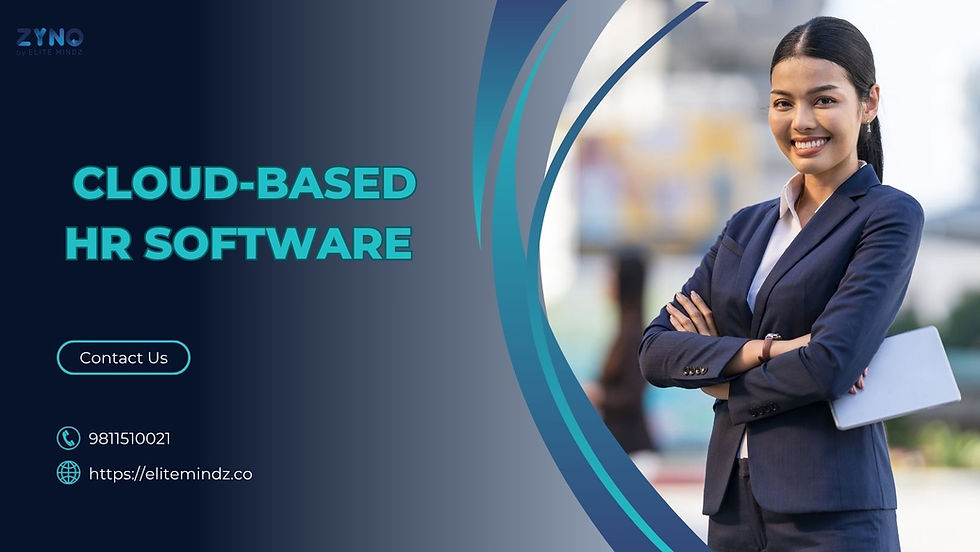Top HRMS Software Features for 2025 & Beyond – Elite Mindz Insight
- priya elitemindz
- Jun 24
- 3 min read
Why is HRMS Software Essential in 2025?
In 2025, HR is no longer restricted to spreadsheets and offline processes. Businesses are shifting to HRMS Software (Human Resource Management System) solutions that are smart, agile, and cloud-ready. The goal is to reduce manual administrative work, empower employees, ensure compliance, and enable strategic decision-making — all under one robust digital HR platform.
As employee expectations evolve and remote work becomes the norm, HRMS software in 2025 must offer mobile access, automation, and scalability. Whether you're a startup or an enterprise, having the right HRMS can dramatically improve employee experience and organizational agility.
Top Features to Look for in HRMS Software in 2025
Choosing the right HRMS in 2025 means looking beyond just basic functionality. Here are the top HRMS features businesses should prioritize:
1. Cloud-Based Architecture
A cloud-based HRMS ensures real-time data access, minimal IT maintenance, and seamless scalability. It’s ideal for remote and hybrid teams, allowing HR data to be accessed securely from any location or device.
2. AI-Fueled Automation
AI and machine learning in HRMS can handle tasks like resume screening, payroll processing, and HR queries via chatbots. This reduces manual workload and speeds up operations.
3. Employee Self-Service Portal
Give your employees more control. A mobile-accessible portal enables staff to manage attendance, leave, tax declarations, and personal details independently.
4. Integrated Payroll Management
Ensure accurate and timely salary processing with automated payroll features — including tax deductions, payslip generation, and bank transfers — while staying compliant with local laws.
5. Attendance and Time Tracking
Modern HRMS software integrates with biometric systems, GPS/geofencing, and mobile punch-in/out. This offers real-time, accurate time tracking for all employees, including field staff.
6. Performance Management System
Support OKRs, KPIs, 360-degree reviews, and continuous performance tracking. A future-ready HRMS should align employee goals with business objectives.
7. Learning & Development (L&D)
With integrated LMS or third-party learning platforms, organizations can deliver training, assign modules, track completion, and upskill their workforce.
8. Recruitment & Onboarding Automation
Simplify hiring with AI resume parsing, job portal integration, applicant tracking, and automated onboarding workflows to boost candidate experience.
9. Real-Time Analytics & Reporting
Use predictive analytics, visual dashboards, and custom reports to track trends like employee engagement, attrition, and compliance risks.
10. Mobile App Support
Field and remote teams benefit from mobile HRMS apps — allowing them to apply for leave, view payslips, and receive updates — even in offline mode.
11. Data Security & Compliance
A trusted HRMS solution in 2025 must comply with global standards like GDPR, SOC 2, and ISO 27001. It should also be flexible enough to adhere to local tax and labor laws.
12. Customization and Scalability
As your company grows, so should your HRMS. Look for modular features, customizable workflows, and role-based access to tailor the system to your evolving needs.
Benefits of Investing in a Future-Ready HRMS
An advanced HRMS system in 2025 brings immense value to your organization. Key benefits include:
Increased HR efficiency through automation
Accurate payroll & compliance with minimal errors
Enhanced employee experience via self-service features
Data-driven HR decisions with smart analytics
Scalable HR operations that support business growth
Conclusion
The right HRMS software in 2025 can completely redefine your HR operations — freeing your HR team from tedious admin work and allowing them to focus on strategy, engagement, and talent development.
At Elite Mindz, we offer a robust, AI-powered, cloud-based HRMS tailored for modern businesses. Whether you’re a startup or an enterprise, our HRMS adapts to your size, goals, and industry. From payroll to onboarding, analytics to L&D — we’ve got you covered.
👉 Book a free demo today and see how EM HRMS can empower your workforce and scale your business confidently.
Frequently Asked Questions (FAQs)
1. What is HRMS Software?
HRMS (Human Resource Management System) is a digital platform that automates and manages HR functions like payroll, attendance, hiring, performance, and compliance.
2. Why is cloud-based HRMS better in 2025?
Cloud HRMS allows secure, real-time data access from anywhere, lowers IT costs, and offers higher flexibility for remote/hybrid teams.
3. Is HRMS suitable for small businesses?
Yes. Modern HRMS vendors offer cost-effective, scalable solutions tailored for SMEs with modular features and flexible pricing.
4. How does AI improve HRMS?
AI boosts efficiency by automating hiring, answering employee queries with chatbots, and enabling predictive analytics for HR decision-making.
5. What’s the difference between HRIS and HRMS?
HRIS is focused on information storage and compliance. HRMS adds extra functionalities like payroll, talent management, and performance tracking.
6. How to choose the right HRMS for my business?
Assess your HR needs, size, budget, and future goals. Prioritize features like AI automation, integration, mobile access, and vendor support. Request demos to evaluate usability.





Comments